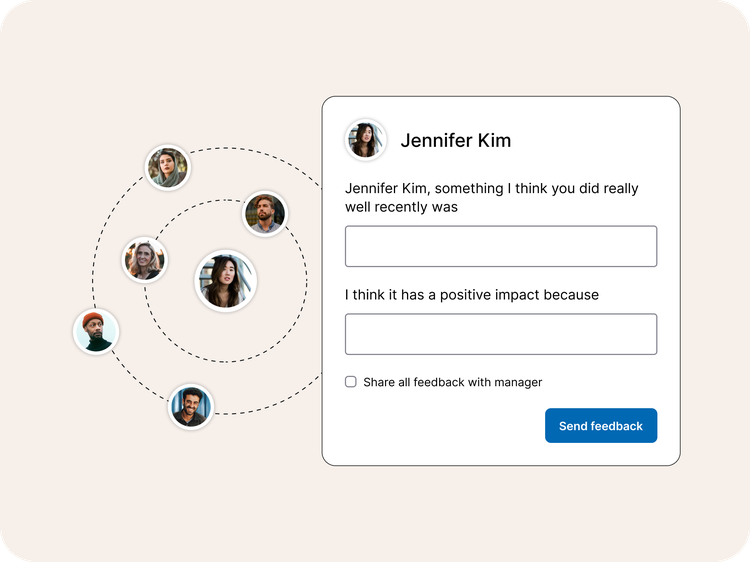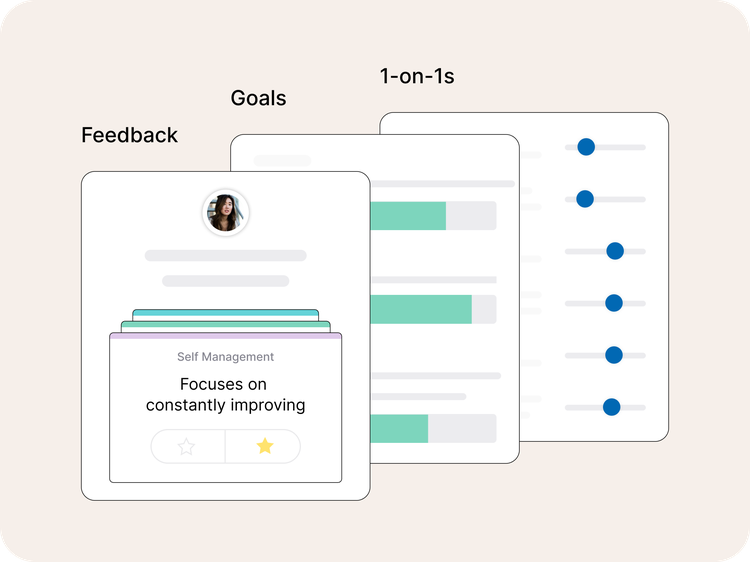
Article

Written by

Senior Content Marketing Manager, Culture Amp
“The annual performance review is dead.”
This sentiment started becoming widespread in the early 2010s when Adobe announced it was eliminating its annual performance review. Companies like Accenture, Deloitte, and Microsoft followed suit shortly afterward. However, as a Harvard Business Review article put it, “The reality is, even when companies get rid of performance evaluations, ratings still exist. Employees just can’t see them. Ratings are done subjectively, behind the scenes, and without input from the people being evaluated.”
Performance reviews can enable fairness, transparency, and growth when approached the right way. Despite their terrible reputation, performance reviews can be a positive process that promotes a culture of continuous development and improvement.
Moreover, research has shown that organizations with employees who are more satisfied with their company’s approach to performance management are
In other words, performance reviews shouldn’t be eliminated but improved and iterated upon. In this article, we take a closer look at why it’s critical to invest in bettering the employee performance review and share seven evidence-based tips to help you improve your performance review process.
According to SHRM, more than 9 in 10 managers are unhappy with their current annual review process, and almost 9 in 10 HR leaders believe that the process doesn’t yield accurate information about performance.
While the frustrations surrounding employee performance reviews are understandable, organizations focus on the wrong thing to “fix.” The “cause” of unpleasant and ineffective performance reviews isn’t the performance review itself. No, the “cause” is the outdated approach many companies still take to measure performance.
Performance reviews are just one piece of the more extensive performance management process. Yet, many organizations approach performance using just one annual performance review. This approach incorporates only performance measurement (how well an employee executed their role-related expectations), which can feel unfair and demotivating.
What’s missing from the equation is performance development. This approach is intended to enable employees to develop new knowledge, skills, and abilities. Employees aren’t “punished” or “rewarded” for how well they met company goals but are assessed and acknowledged in terms of their potential and desire to grow and improve.
Both performance measurement and performance development are essential for creating a performance management process that inspires and motivates your employees to go above and beyond at your organization. Performance reviews can be utilized to achieve this, but you must remember that performance reviews are just one part of a holistic process that includes regular 1-on-1 meetings, self-reflections, goal-setting, continuous feedback, 360° reviews, calibrations, and more.
On top of being an essential part of the performance management process, well-designed performance reviews also bring the following benefits:
Now that we’ve established the advantages of holding performance reviews, how can companies improve the process? Below, we share seven actionable tips companies can use to improve performance reviews.
One of the most effective ways to improve the performance review process is to make it part of an ongoing process. Rather than give employees feedback once or twice a year, establish an environment where employees and managers have frequent check-ins around performance, goals, and development. You can also consider holding your performance review on a more frequent cadence – for example, Culture Amp holds performance syncs twice a year, which include growth check-ins, a performance sync, coaching, and regular 1-on-1 conversations.

With such an approach, performance reviews don’t feel as siloed. Employees will also feel like their feedback is fair, as they’ve been receiving feedback throughout the year.
Words matter – especially when it comes to employee performance reviews. It’s essential to ensure people use the right phrases during a performance review. Feedback should be clear, empathetic, and actionable – the last thing a manager should do is share comments with a direct report that are misinterpreted or don’t give them a clear way forward.
For instance, saying, “The whole team feels stressed out by your behavior,” is unhelpful feedback. Giving feedback like this leaves the employee with many questions, such as: “Did the entire team actually complain about me?” and “What behavior is stressing them out?” It can also make the employee feel paranoid and alienated from the rest of the team.
Rather, train your managers to give feedback such as: “My feedback is that you stop sending emails late at night. You’re creating stress for the other team members outside of working hours, and it’s not a healthy habit for you either.” This clarifies what behavior is causing the stress and why it’s important to stop it.
According to a study by SHRM, only 1 in 3 employees feel like they’re being evaluated fairly. Given this, it’s important to be highly cognizant of common biases that can come up during the employee performance review such as primacy bias, which is when someone focuses on information learned early on in a relationship, such as first impressions, instead of actual performance.
Another common problem is using gendered language during the employee performance review. A study found that women's evaluations contain nearly twice as much language referencing a communal or nurturing style, such as "helpful" or "dedicated." Managers are also almost seven times more likely to tell their male employees that their communication style is too “soft.” At the same time, women receive 2.5 times as much feedback about communicating too aggressively.
Biases are often unconscious, which is why it’s important for leaders to create safeguards against them. For example, one organization audited its performance reviews for gender and racial biases and decided to rework the performance review form that required evidence-backed ratings. They also developed a one-hour workshop to teach employees about patterns of bias.
Performance reviews are a process that requires vulnerability from both employees and managers, which makes it essential for the relationship between the two parties to be built on trust and transparency. While this may seem obvious, research has actually found that while managers are one of the most important levers for effective performance management, many companies fail to empower managers with the time and resources they need to foster high performance, have difficult conversations with their teams, and pave the path for their employees to do their best work.
Rating scales are often a necessary component of an employee performance review. Well-designed performance rating systems help differentiate high performance from low performance, identify areas of improvement, and offer transparency in decision-making. At Culture Amp, we recommend a four-point rating scale similar to what's depicted below.

Research even shows that top performers can outperform the rest by over 400% – something you wouldn’t be able to identify without rating performance. However, they’re not one-size-fits-all, so it’s critical to understand exactly what you’re looking for in your rating scale and customize it to your needs.
Many organizations tie performance to recognition, compensation, and promotions. Given that an employee’s livelihood depends on the performance review, the process must be as fair as possible. In particular, it’s essential to make sure your top-performing employees are getting the recognition they deserve so they don’t feel underappreciated or unrewarded for their efforts and successes.
It’s also important for low-performing employees to understand their areas of improvement in the context of the criteria they’re being measured against. That way, low-performing employees understand what they need to specifically improve to get to the next level.
Making sure the alignment between performance and recognition is as straightforward and clear as possible will not only help employees contribute to the company’s success but will also keep employee morale high.
Finally, choosing the right performance tool can make a big difference in the employee performance review experience. Old-school performance tools are often inflexible, inaccurate, and cumbersome to use. If your team still uses an HRIS for performance management, consider the benefits of a streamlined performance solution explicitly built for high-feedback workplaces.

There are four main capabilities to look for when picking the right performance management tool – while the tool alone won’t fix all of your performance-related issues, it can be an excellent catalyst to seamlessly set into motion all the other changes.
Don’t give up on the employee performance review yet – you have the power to make small but significant changes that improve the overall process and deliver significant value to both your managers and employees. By using these seven tips to improve your performance review experience, you can set the foundation for a workplace culture that supports continuous growth and high performance.
